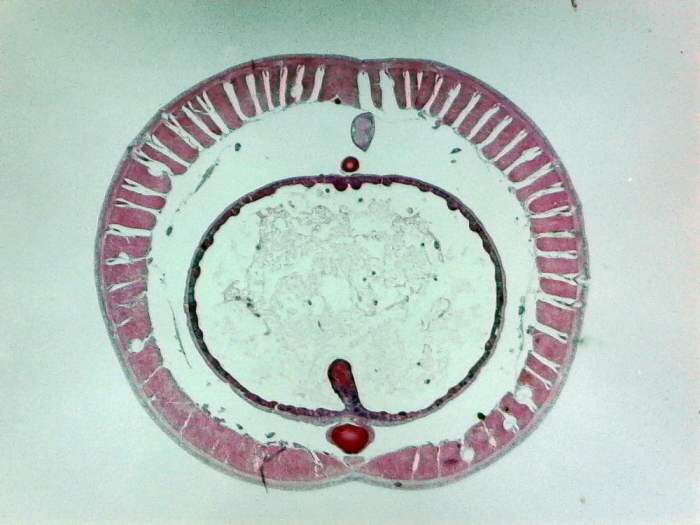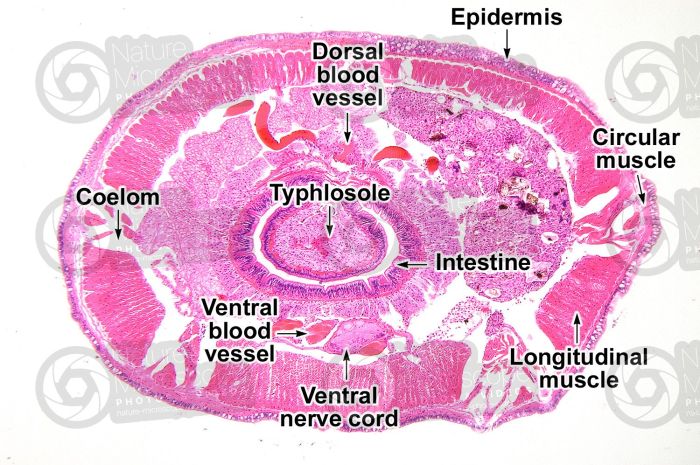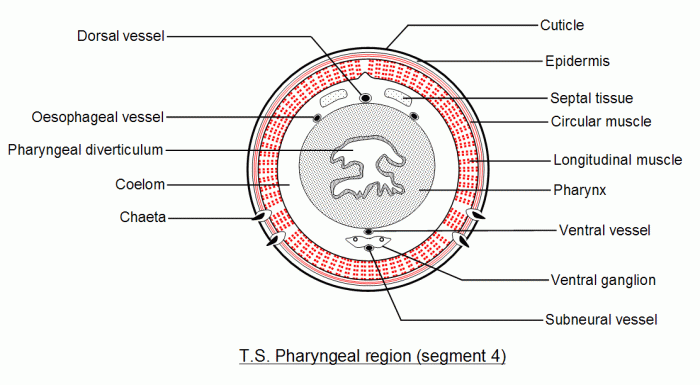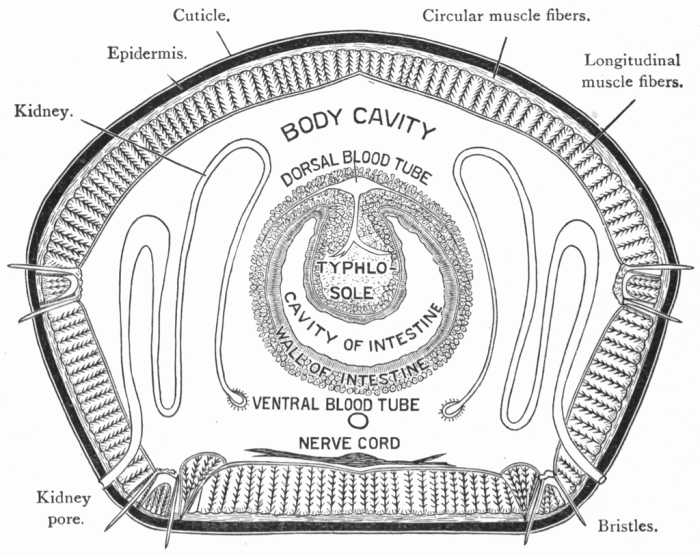Cross section of an earthworm – Prepare to delve into the fascinating world of earthworms as we embark on a cross-sectional journey to uncover the intricacies of their anatomy and physiology. From their external appearance to their intricate internal systems, we will unravel the secrets that make these humble creatures essential players in our ecosystems.
Earthworms, known for their cylindrical bodies and segmented structure, possess a unique set of adaptations that enable them to thrive in diverse environments. Their digestive, circulatory, nervous, and reproductive systems work in harmony to sustain their life processes and contribute to the overall health of the soil they inhabit.
External Anatomy: Cross Section Of An Earthworm

Earthworms, also known as “night crawlers” or “angleworms,” are fascinating creatures that play a crucial role in the health and fertility of our soil. Their external anatomy exhibits distinct characteristics that are not only visually intriguing but also essential for their survival and function.The
most striking feature of an earthworm is its elongated, cylindrical body. Its length can vary greatly depending on the species, ranging from a few centimeters to over a meter. The body is covered in a thin, moist cuticle that protects the worm from dehydration and physical damage.One
of the most distinctive features of earthworms is their segmentation. Their bodies are divided into numerous segments or rings, each of which contains a set of muscles and internal organs. This segmentation allows earthworms to move efficiently through the soil by contracting and expanding different segments.Another
important external feature of earthworms is the clitellum. The clitellum is a thickened, saddle-shaped band that encircles the worm’s body near its middle. This specialized structure plays a vital role in reproduction, producing the eggs and sperm necessary for fertilization.
Locomotion
Earthworms move by contracting and expanding their body segments, using their muscles to generate a wave-like motion. The small bristles or setae located on each segment provide traction, helping them to grip the soil and move forward.
Sensory Organs
Despite their lack of eyes, earthworms possess sensory organs that allow them to detect light, touch, and chemicals. They have light-sensitive cells on their skin that can distinguish between light and dark. Additionally, they have touch receptors that can sense pressure and vibrations, helping them to navigate their environment.
Feeding
Earthworms are detritivores, feeding primarily on decaying organic matter in the soil. They use their muscular pharynx to ingest soil, which is then passed through their digestive system. As the soil moves through the digestive tract, the earthworm absorbs nutrients and expels the remaining material as castings, which are rich in nutrients and beneficial for soil health.
When observing the cross section of an earthworm, it’s fascinating to see its intricate internal structure. To explore another captivating scientific topic, delve into the air mass and fronts worksheet . Upon returning to the earthworm’s cross section, you’ll appreciate the remarkable complexity of this segmented creature.
Digestive System
Earthworms possess a well-developed digestive system adapted to their unique diet and lifestyle. Their digestive tract is a long, tubular structure that runs through the length of their body, facilitating the efficient breakdown and absorption of nutrients.
The digestive process in earthworms involves several specialized organs, each playing a specific role in the breakdown and absorption of food. These organs are organized in a sequential manner, forming a complete digestive system.
Organs of the Digestive Tract
The following table provides an overview of the organs involved in the earthworm’s digestive system and their respective functions:
| Organ | Function |
|---|---|
| Mouth | Ingestion of food particles |
| Pharynx | Moistening and lubrication of food |
| Esophagus | Transportation of food to the crop |
| Crop | Temporary storage and softening of food |
| Gizzard | Mechanical breakdown of food particles |
| Intestine | Absorption of nutrients and water |
| Anus | Excretion of undigested materials |
Digestive Process
The digestive process in earthworms begins with the ingestion of organic matter through the mouth. The pharynx then secretes mucus to moisten and lubricate the food, aiding its passage through the esophagus. The esophagus transports the food to the crop, where it is temporarily stored and softened.
From the crop, the food moves into the gizzard, a muscular organ lined with chitinous teeth. The gizzard’s rhythmic contractions mechanically break down the food particles into smaller fragments, increasing their surface area for efficient digestion.
The partially digested food then enters the intestine, the longest portion of the digestive tract. Here, digestive enzymes are secreted to further break down the food and absorb nutrients. The intestine is lined with tiny villi, which increase the surface area for absorption.
Water is also absorbed from the food in the intestine, resulting in the formation of feces. The undigested materials are eventually excreted through the anus.
Role of the Gizzard
The gizzard is a unique and crucial organ in the earthworm’s digestive system. Its muscular structure and chitinous teeth enable it to grind and crush food particles, a process essential for the efficient breakdown of organic matter. This mechanical breakdown increases the surface area of the food, allowing digestive enzymes to work more effectively in the intestine.
The gizzard’s role is particularly important in earthworms’ diet, which often consists of tough and fibrous plant material.
Circulatory System

Earthworms possess a closed circulatory system, meaning that their blood is contained within blood vessels. This system is responsible for transporting nutrients, oxygen, and waste products throughout the body.
The earthworm’s circulatory system consists of two main blood vessels: the dorsal blood vessel and the ventral blood vessel. The dorsal blood vessel runs along the top of the body, while the ventral blood vessel runs along the bottom.
Dorsal and Ventral Blood Vessels
The dorsal blood vessel is responsible for carrying blood away from the heart. It is a thick-walled vessel that is lined with muscles. The ventral blood vessel is responsible for carrying blood back to the heart. It is a thin-walled vessel that is not lined with muscles.
Hemoglobin
Hemoglobin is a protein that is found in the blood of earthworms. Hemoglobin binds to oxygen molecules and transports them throughout the body. This allows the earthworm to breathe even in low-oxygen environments.
Nervous System

The nervous system of an earthworm is a complex network of nerves and nerve centers that allows the worm to sense its surroundings and respond accordingly. The nervous system is made up of the brain, the ventral nerve cord, and a series of peripheral nerves.
The brain of an earthworm is located in the prostomium, or “head” of the worm. The brain is responsible for coordinating the worm’s responses to stimuli. It receives information from the worm’s sensory organs and sends out signals to the worm’s muscles and glands.
Ventral Nerve Cord
The ventral nerve cord is a long, thin nerve cord that runs along the ventral side of the worm’s body. The ventral nerve cord is responsible for transmitting signals between the brain and the rest of the body. It also contains a series of ganglia, which are small clusters of nerve cells that serve as relay stations for signals.
Reproductive System

Earthworms are hermaphrodites, meaning they possess both male and female reproductive organs. This unique characteristic allows them to self-fertilize or mate with another earthworm to produce offspring.
The reproductive systems of male and female earthworms are similar in structure but differ in specific functions:
| Reproductive Organ | Male Earthworm | Female Earthworm |
|---|---|---|
| Testes | Produce sperm | Not present |
| Sperm Ducts | Transport sperm to the seminal vesicles | Not present |
| Seminal Vesicles | Store sperm | Not present |
| Prostates | Produce seminal fluid | Not present |
| Ovaries | Not present | Produce eggs |
| Oviducts | Not present | Transport eggs to the clitellum |
| Clitellum | Secretes a mucus cocoon for eggs | Secretes a mucus cocoon for eggs |
Sexual Reproduction in Earthworms, Cross section of an earthworm
Sexual reproduction in earthworms involves the exchange of sperm between two individuals. During mating, the clitellum of each earthworm swells and secretes a mucus cocoon. The earthworms align themselves head-to-tail and exchange sperm, which is stored in the seminal vesicles of the male earthworm.
The eggs produced by the female earthworm are fertilized by the sperm and deposited into the mucus cocoon. The cocoon then detaches from the earthworms and forms a protective environment for the developing embryos.
Development of the Earthworm from Egg to Adult
The development of an earthworm from egg to adult involves several stages:
- Embryonic Development:The fertilized eggs undergo cell division and differentiation to form an embryo.
- Hatching:The embryos hatch from the eggs after about two to three weeks.
- Juvenile Stage:The newly hatched earthworms are called juveniles and resemble miniature adults.
- Adult Stage:The juveniles undergo growth and development, reaching sexual maturity and becoming fully functional adults.
The entire process of development from egg to adult typically takes around three to four months.
User Queries
What is the function of the clitellum in earthworms?
The clitellum is a specialized region of the earthworm’s body responsible for producing the cocoon that houses the developing embryos.
How does the earthworm’s digestive system process food?
Earthworms ingest soil and organic matter, which is then broken down in the gizzard and intestine through mechanical and enzymatic action.
What is the role of hemoglobin in the earthworm’s circulatory system?
Hemoglobin, present in the earthworm’s blood, binds to oxygen and facilitates its transport throughout the body.